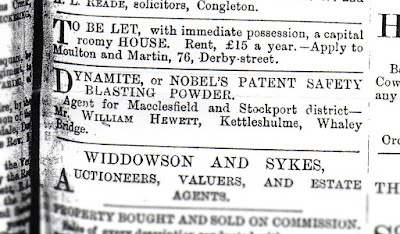Marie Cunningham has been researching a footpath leading westwards from Neighbourway Farm in Kettleshulme and in doing so has discovered some fascinating local history.
Turn down Side End Lane, alongside St.James Primary School, and after about 150 metres a narrow road leads off to the right. This road only serves a few farms and eventually peters out. About half way along is Neighbourway Farm which is also known as Green Low Heath. Opposite the farmhouse is a short track leading across the field and this is the start of an alleged footpath leading westwards across Todd Brook, towards Charleshead Farm. Although the path appears on some maps, its route is uncertain and the right of way has never been enforced. This little road is just over 150 metres long and at the end is a small windowless brick built structure which had a slate roof which has fallen in but the walls are still standing. Not much is known about the hut but Peter Garlick of Neighbourway has always known it as the Gunpowder Hut. The Garlick family has lived at Neighbourway since c1930. Jim Etchells who lived close by at Near Carr told Peter that a member of the Hewitt Family lived at Charleshead and collected gunpowder from the hut. He stated in 1993 that the gunpowder hut was used up to the time of the first World War.
The Hewitt family were involved in mining in the area.
Jas Hewitt lived at Green Low Heath (Neighbourway farm) Kettleshulme. (Kelly's Directory of Cheshire 1892, the 1901 census and the Finance Act (1910) record of 1913.
John Hewitt lived at Winters Close, Rainow. (The 1910 Finance Act records)
Margaret Hewitt was at Dales Farm c1913
Sydney Hewitt was an agricultural implement dealer in Kettleshulme - no location given (Kelly's directory of Cheshire 1914)
William Hewitt was an iron steel and implement merchant and in 1906 was Kettleshulme sub-postmaster (Kelly's directory 1906)
Dales farm, as well as being the post office, is the location of the shop which Marie believes was where the gunpowder was sold. It's a stone built low level building at the end of the house which fronts the main road opposite the school but it is two storey at the rear. Raymond Lomas can remember c1950 the paraffin cans etc which had been left behind when the shop closed
Could Mr Hewitt have lived at Greenlow Heath and built the gunpowder hut because he was an agent for the Nobel Dynamite Company ?
Marie has found a snippet of information in a book "Rainow Caught in Time" written by the Rainow History Group it reads
"In June 1878 there was an experiment with dynamite at the home of Mr Sutton in Tower Hill. Several unsuccessful attempts had been made by a local miner to blow up a very large tree root with ordinary blasting powder.
Mr Hewitt of Kettleshulme, agent for the Nobel Dynamite Company experimented with the use of dynamite and successfully blew it to pieces"
On the other side of Todd Brook is an area of marshy land which was used to grow willow for basket making. The man-made clay pans and drainage channels used for growing the willow can still be seen on the ground but once again more detail is not known
The Hewitt family were long associated with Furness Clough Colliery as well as managing Castedge Mine in the Goyt Valley and the pits at Charleshead.
Dynamite was the invention in 1867 of Swedish chemist and inventor, Alfred Nobel (1833 - 1896), just one of his 355 patents. On his death, most of his wealth was left in trust to fund the Nobel Prize.
The British Dynamite Company was established by Nobel in Ayrshire in 1871. At its peak it employed nearly 13,000 workers. The name changed to Nobel's Explosives Ltd in 1877 but the name disappeared through mergers at the time of the First World War although it was resurrected in 1920.
Marie is still researching the subject of both the Gunpowder Hut and the footpath and would appreciate any further information. Please write to furnesshistory@gmail.com
 |
| from a Macclesfield newspaper of June 1878 |
 |
| Location of Neighbourway and the Gunpowder Hut |


permission to reproduce this on the chorltonhistory blog please
ReplyDelete